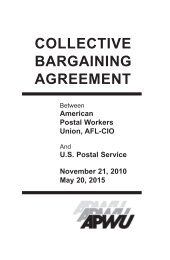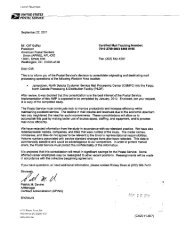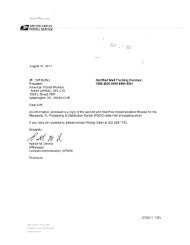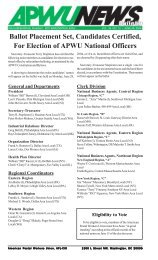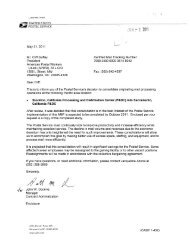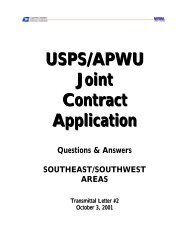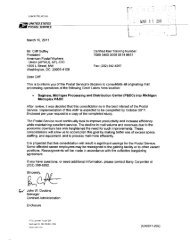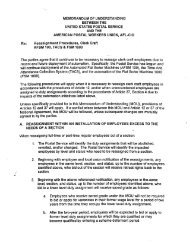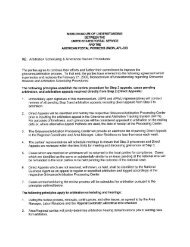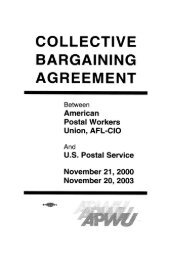- Page 1 and 2:
Publication 129October 1990
- Page 3 and 4:
Safety TalksContents p. iContentsCh
- Page 5 and 6:
Safety Talks 1-1IntroductionPurpose
- Page 7 and 8:
Safetv Talks 1-22. Summary. Remembe
- Page 9 and 10:
Safety Talks 1-3What a Smervisor Ca
- Page 11 and 12:
Safety TalksChapter 2: HEALTH AND W
- Page 13 and 14:
Safetv Talks 2-2How Does Substance
- Page 15 and 16:
2-2 Safety TalksHow does substance
- Page 17 and 18:
Safety Talks 2-5Sun Can Be Fun. But
- Page 19 and 20:
Safetv T a l k s 2-6SunstrokeIt Can
- Page 21 and 22:
Safetv T a l k s 2-8Heatstroke and
- Page 23 and 24:
9-Q Safetv TalksMaintain a Balance.
- Page 25 and 26:
Safety Talks 2-11Stress - How to Co
- Page 27 and 28:
Safety TalksChapter 3: PREVENTING D
- Page 29 and 30:
3-1 Safety TalksAnswers1. False. Do
- Page 31 and 32:
Safety Talks 3-3Putting the Bite on
- Page 33 and 34:
Safetv T a l k s 3-4What You Should
- Page 35 and 36:
3-5 Safety TalksIf a dog threatens
- Page 37 and 38:
3-6 Safety Talks7. Try to make frie
- Page 39 and 40:
Safetv Talks 4-1Water and Electrici
- Page 41 and 42:
Safetv Talks 4-1GFCI: The Circuit S
- Page 43 and 44:
Safetv Talks 4-2Electricity - Frien
- Page 45 and 46:
Safety Talks 4-3Grounds for Caution
- Page 47 and 48:
Safety TalksChapter 5: SLIPS, TRIPS
- Page 49 and 50:
5-1 Safetv Talks8. Safe or unsafe?
- Page 51 and 52:
5-7 Safetv TalksQuestion:falls?Whic
- Page 53 and 54:
Safetv Talks 5-4OffIce HasteIf you
- Page 55 and 56:
Safetv Talks 5-5Stairway SafetyEver
- Page 57 and 58:
Safety Talks 5-6Use HandrailsMany o
- Page 59 and 60:
Safetv Talks 5-7Work ShoesToday I
- Page 61 and 62:
Safetv Talks 5-8Winter WalkingThis
- Page 63 and 64:
Safety Talks 6-1Fire FactsCan fire
- Page 65 and 66:
Fire SafetyMost of you have probabl
- Page 67 and 68:
Safetv Talks 6-3Fire Prevention Wee
- Page 69 and 70:
Safetv Talks 6-4Flammable and Combu
- Page 71 and 72:
6-5 Safetv Talks--Gasoline should b
- Page 73 and 74:
6-6 Safetv TalksHow Can We Help Our
- Page 75 and 76:
6-7 Safetv TalksMaintenance. Have y
- Page 77 and 78:
Safety Talks 7-1Check Your Housekee
- Page 79 and 80:
Safetv Talks 7-2How’s Your “Eye
- Page 81 and 82:
Safetv Talks 7-3Keep It Clean For S
- Page 83 and 84:
7-4 Safety TalksAnswers1. False. Al
- Page 85 and 86:
7-5 Safety TalksAnswers2. Unsafe. D
- Page 87 and 88:
7-6 Safety TalksDoors are a source
- Page 89 and 90:
Safetv Talks 8-1Do You Use Safe Lif
- Page 91 and 92:
Safetv Talks 8-2Do’s and Don’ts
- Page 93 and 94:
Safetv Talks 8-4Team LiftingWhat is
- Page 95 and 96:
Safety TalksChapter 9: PERSONAL PRO
- Page 97 and 98:
Safety Talks9-1.4nswerS1. Gloves. I
- Page 99 and 100:
Safetv Talks 9-3Safe EyesWhile perf
- Page 101 and 102:
Safetv T a l k s 9-4Hand Protection
- Page 103 and 104:
Safety TalksChapter 10: MACHINERY,
- Page 105 and 106:
1(-)-1 Safety TalksAnswers[. True.
- Page 107 and 108:
1-Safetv Talks 10-3Watch Out for Ni
- Page 109 and 110:
Safety Talks 10-4Conveyor SafetyWhy
- Page 111 and 112:
1-Safetv Talks 10-5Lockout for Safe
- Page 113 and 114:
l-Safety Talks 10-6Lockout BasicsTh
- Page 115 and 116:
Safetv Talks 10-7Use the Lockout Pr
- Page 117 and 118:
Safety Talks 10-8Lock It Out!You’
- Page 119 and 120:
Safetv Talks 10-9Hand Held Tools -
- Page 121:
Safetv Talks1o-1oLadder SafetyIt’
- Page 124 and 125:
10-11 Safetv TalksMaintenance. All
- Page 126 and 127:
10-12 Safetv TalksThe ordinary stra
- Page 128 and 129:
Safetv Talks 11-1Be a Professional
- Page 130 and 131:
11-7 Safety TalksAnswers1. F. All o
- Page 132 and 133:
11-3Safety TalksDon’t let the oth
- Page 134 and 135: 11-4 Safetv TalksAwareness is the k
- Page 136 and 137: 11-5 Safetv TalksMyth: Z don’t ne
- Page 138 and 139: 11-6 Safetv TalksHolding a child in
- Page 140 and 141: 11-7 Safety Talks4. A collision wit
- Page 142 and 143: 11-8 Safety TalksThere’s an older
- Page 144 and 145: Safety Talks 11-9Look Twice Before
- Page 146 and 147: Safetv Talks 11-10Intersections Des
- Page 148 and 149: 11-11 Safetv TalksDrivers should no
- Page 150 and 151: 11-12 Safetv TalksTo avoid having a
- Page 152 and 153: 11-13 Safety Talks4. Fired objects
- Page 154 and 155: Safety Talks 11-15Gear Up for Winte
- Page 156 and 157: 11-16 Safetv Talks9. Watch our for
- Page 158 and 159: 11-17 Safety TalksOn any medium or
- Page 160 and 161: Safetv Talks 11-19Winter Drivimz -
- Page 162 and 163: Safetv Talks 11-20Starting, Stoppin
- Page 164 and 165: Safety Talks 11-21Driving in FogIn
- Page 166 and 167: Safety Talks 11-22Driving in RainSu
- Page 168 and 169: Safety Talks 11-23Disaster DrivingK
- Page 170 and 171: l-Safetv Talks 11-24Caution - Railr
- Page 172 and 173: Safety Talks 11-25Do You Use Extra
- Page 174 and 175: Safety Talks 11-26Motorcyclists Are
- Page 176 and 177: Safetv Talks 11-27How to Smt a Drun
- Page 178 and 179: Safety Talks 11-28Don’t Let a Dru
- Page 180 and 181: 11 -XI Safetv TalksAnd while we’r
- Page 182 and 183: Safety Talks 12-1Are You Cautious A
- Page 186 and 187: Safetv Talks 12-3Powered Industrial
- Page 188 and 189: Safetv Talks 12-4Tins for Safe Indu
- Page 190 and 191: Safetv Talks 12-5Powered Industrial
- Page 192 and 193: Safety TalksChapter 13: MISCELLANEO
- Page 194 and 195: 13-1 Safety Talks.Maybe some of us
- Page 196 and 197: 13-2 Safety TalksAnswers1. The empl
- Page 198 and 199: 13-3 Safety TalksAnswers1. True. Ha
- Page 200 and 201: 13-4 Safetv TalksTogether, you and
- Page 202 and 203: 13-5 Safety TalksSafe housekeeping
- Page 204 and 205: 13-6 Safetv TalksfO. Safe or unsafe
- Page 206 and 207: 13-7 Safety TalksWhat are the Sympt
- Page 208 and 209: Safetv Talks 13-9Summertime - Schoo
- Page 210 and 211: Safety Talks 13-9‘Tis the Season
- Page 212 and 213: Safety TalksChapter 14: OFF-THE-JOB
- Page 214 and 215: Safetv Talks 14-2Keep in Shape, But
- Page 216 and 217: Safetv Talks 14-3JoggingThe arrival
- Page 218 and 219: 14-3 Safety TalksProper clothingIn
- Page 220 and 221: 14-4 Safetv Talks9. Safe or unsafe?
- Page 222 and 223: 14-5 Safety TalksAnswers1. Susan ha
- Page 224 and 225: 14-6 Safety TalksEnjoy outdoor cook
- Page 226 and 227: 1A-RSafetv TalksWhen a flood “war
- Page 228 and 229: 14-9 Safetv TalksThe best first aid
- Page 230 and 231: Safetv Talks 14-11Do You Throw Caut
- Page 232 and 233: Safety Talks 14-12Selecting a Safe
- Page 234 and 235:
Safetv Talks 15-1Bombs in the MailT
- Page 236 and 237:
Safety Talks 15-3Themes and Schemes
- Page 238 and 239:
Safetv Talks 15-4How Not to Get Con
- Page 240 and 241:
Safety Talks 15-5Avoiding SwindlesC
- Page 242 and 243:
Safetv Talks 15-6How to Crimeproof
- Page 244 and 245:
Safetv T a l k s 15-7Prevent Burgla
- Page 246 and 247:
Safetv Talks 15-8Protect Your Post
- Page 248 and 249:
Safetv Talks 15-10Operation Identif
- Page 250 and 251:
15-11 Safety Talks9. With an electr
- Page 252 and 253:
15-12 Safety Talks8. Unpacking. Onc
- Page 254 and 255:
15-13 Safetv Talks7. Don ‘t give
- Page 256 and 257:
15-14 Safety TalksIdentifying marks
- Page 258 and 259:
Safetv Talks 15-16Arson - How Not t
- Page 260 and 261:
safety TalksChapter 16: HAZARDOUS M
- Page 262 and 263:
Safetv Talks 16-2Material Safety Da
- Page 264 and 265:
Safetv Talks 16-3Reading Material S
- Page 266 and 267:
Safetv Talks 16-4Chemical Warning L
- Page 268 and 269:
Safetv Talks 16-5Working with Solve
- Page 270 and 271:
Safetv Talks 16-6Emergencies Involv
- Page 272 and 273:
Safety Talks 16-7Handling Corrosive
- Page 274 and 275:
Safetv Talks 16-8Emergencies Involv
- Page 276 and 277:
Safety TalksChapter 17: SAFETY AND
- Page 278 and 279:
17-1 Safety TalksTrue or false. Dri
- Page 280 and 281:
17-2 Safety TalksA cutting tool is
- Page 282 and 283:
17-3 Safetv TalksWhat is the bigges
- Page 284 and 285:
17-4 Safety TalksWhat is the safest


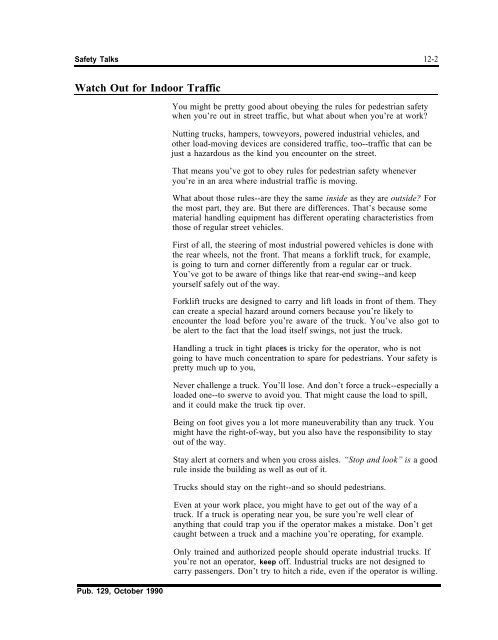

![Dec. 9 letter to Sen. Murray and Rep. Ryan [PDF] - APWU](https://img.yumpu.com/51737602/1/190x245/dec-9-letter-to-sen-murray-and-rep-ryan-pdf-apwu.jpg?quality=85)
![these offices [PDF] - APWU](https://img.yumpu.com/51694952/1/190x245/these-offices-pdf-apwu.jpg?quality=85)
